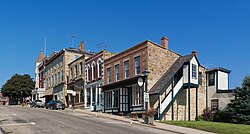Iowa County, Wisconsin | |
|---|---|
 Iowa County Courthouse in March 2013 | |
 Location within the U.S. state of Wisconsin | |
| Coordinates: 43°00′N90°08′W / 43°N 90.13°W | |
| Country | |
| State | |
| Founded | 1830 |
| Named after | Iowa people |
| Seat | Dodgeville |
| Largest city | Dodgeville |
| Area | |
• Total | 768 sq mi (1,990 km2) |
| • Land | 763 sq mi (1,980 km2) |
| • Water | 5.4 sq mi (14 km2) 0.7% |
| Population | |
• Total | 23,709 |
• Estimate (2024) | 23,963 |
| • Density | 31.1/sq mi (12.0/km2) |
| Time zone | UTC−6 (Central) |
| • Summer (DST) | UTC−5 (CDT) |
| Congressional district | 2nd |
| Website | www |
Iowa County is a county in the U.S. state of Wisconsin. As of the 2020 census, the population was 23,709. [1] Its county seat and largest city is Dodgeville. [2] When created, it was part of the Michigan Territory. Iowa County is part of the Madison, Wisconsin, Metropolitan Statistical Area.
Contents
- History
- Geography
- Rivers and streams
- Major highways
- Railroads
- Buses
- Airport
- Adjacent counties
- Demographics
- 2020 census
- 2000 census
- Politics
- Parks and recreation
- Communities
- Cities
- Villages
- Towns
- Census-designated place
- Unincorporated communities
- Ghost towns
- Notable people
- See also
- References
- Further reading
- External links




